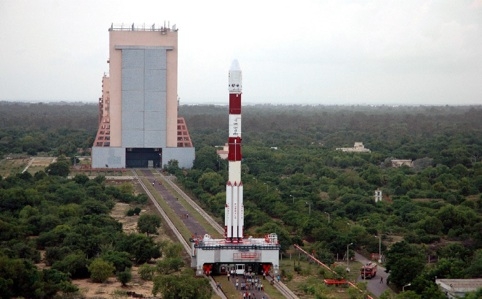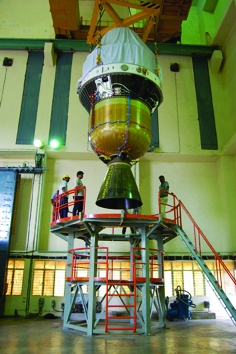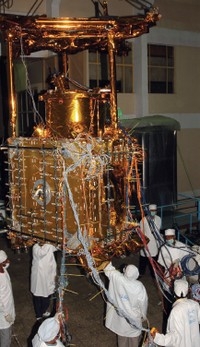What do you call an Indian astronaut? It’s not a question that has ever needed much attention outside the realm of idle speculation, but think about it for a minute. Astronauts are American, of course. Cosmonauts are Russian and we’ve recently added Taikonauts - Chinese spacemen - to the list of star travellers. But with India’s space programme hitting the headlines with the staggering discovery of water on the moon, it’s soon likely to be time for a new category.
The Chandrayaan moon mission was the first foray into planetary science by the Indian Space Research Organisation (ISRO). Launching late last year, it carried an orbiter and impacter probe -based on Indian-developed and produced technology - atop a similarly home-built rocket launched from Indian territory.
Chandrayaan (the name means moon vehicle in Sanskrit) also carried instruments from other organisations, including ESA, NASA and the Bulgarian Academy of Sciences.
The mission met with mixed success. It was intended to last for two years but was terminated after 10 months after communication with the spacecraft was lost. ISRO’s then chairman, Madhavan Nair, said that power supplies for the craft’s computer systems had been damaged by very high radiation levels; a problem that hadn’t been anticipated. ‘We have learned some valuable lessons and we have to look for devices that are less susceptible to radiation in future,’ he said.

Yet this apparent failure (‘apparent’ because Chandrayaan actually achieved 95 per cent of its objectives) was turned into spectacular success when one of NASA’s instruments aboard the Chandrayaan orbiter, the Moon Mineralogy Mapper (M3), discovered water on the moon’s surface by detecting the telltale energy-absorption wavelengths of oxygen-hydrogen bonds. Another instrument aboard the craft, ESA’s Sub-keV Atom Reflecting Analyser (SARA), discovered that the water is actually generated on the moon, with protons from the solar wind being absorbed into the minerals of the lunar surface and combining with oxygen to make water molecules. Data from two other spacecraft also contributed to the discovery, which Nair called a ‘grand success’ for Chandrayaan.
The successor mission, Chandrayaan-2, is already in the planning stages, with a launch slated for December 2013 and a projected cost of Rs4.25bn (£540m).
The Indian space programme’s roots go back a surprisingly long way (see timeline panel). Like China’s space programme, India’s initially grew out of the Cold War - with rocket development in the hands of the Department of Atomic Energy and close collaboration with Soviet space science. Not wanting to be dependent on Russian launchers for its satellites, ISRO decided to develop its own launchers. The first of which - with the prosaic name Satellite Launch Vehicle (SLV) - had its first flight in 1979.
“We have learned some valuable lessons, and we have to look for devices that are less susceptible to radiation in future”Madhavan Nair, former chairman, ISRO
Only two of SLV’s four launches were successful and its successor, the Augmented SLV, also only managed two successful test flights out of four. However, India’s two current rockets, the Polar Satellite Launch Vehicle (PSLV) and the Geosynchronous Satellite Launch Vehicle (GSLV), are performing well. PSLV has so far launched 30 spacecraft - 16 of which were Indian - into orbit. GSLV, a three-stage heavy launcher with solid, liquid and cryogenic fuel stages, is designed to carry payloads weighing up to five tonnes into orbit and is specifically designed to launch India’s multipurpose telecom, broadcasting, weather-monitoring and reconnaissance satellites - known as INSAT (Indian National Satellite System).

Previously, India had to depend on Russian launchers for the INSAT programme, but the last three INSAT launches have used GSLVs. The fourth GSLV flight, however, went off course in July 2006 due to a malfunctioning propellant system on one of the launcher’s strap-on booster rockets and had to be destroyed over the Bay of Bengal, with the loss of its payload.
The launch-vehicle programme is an important part of India’s space industry, with PSLV the key component of a commercial satellite-launching programme. Nair noted that there are relatively few launch vehicles suitable for small satellites; ‘PSLV could be the appropriate vehicle for many customers,’ he said. Indeed, Chandrayaan-1 was launched on a PSLV, demonstrating the rocket’s potential and versatility.
GSLV is currently at the centre of what will be a major milestone for ISRO. Its geosynchronous launching capability depends on the use of a powerful cryogenic engine - using liquefied oxygen and hydrogen as fuel. So far, only NASA, ESA and the Russian and Japanese space agencies have developed cryogenic engines, and ISRO’s attempts to buy the technology in the 1980s hit problems. The US and European engines were deemed too expensive and negotiations with Japan were fruitless.
In 1988, ISRO agreed to buy cryogenic engines from the USSR. These had originally been developed for the abandoned Soviet programme to land men on the moon. However, the US government - under President Bush Senior - objected to the sale of engines and technology know-how under rules preventing the spread of missile technology, and threatened sanctions. President Clinton’s administration then suggested a compromise, that only flight-ready engines would be supplied, and ISRO bought seven engines.
India’s space endeavours span five decades
1962 Indian National Committee for Space Research founded
1963 First Indian rocket launch
1969 ISRO formed
1975 First Indian satellite, Arhyabata, launched from Volgograd
1979 First flight of SLV
1980 SLV puts test satellite into orbit
1983 Final SLV launch
1987 First ASLV launch
1992 First INSAT communications satellite placed in orbit
1993 First PSLV launch
2001 First GSLV launch
2008 Chandrayaan-1 launch
Now India has developed its own cryogenic engine. Developed at the Liquid Propulsion Systems Centre in the southern state of Kerala - the home of ISRO headquarters and the centre for Indian space science - the engine underwent a 720sec static test burn in mid-November. This is the full duration for a geosynchronous orbit insertion and the engine is planned to be in place for the next GSLV launch before the end of 2009.
Clearly, one thing that India’s space programme has in abundance is ambition. The Chandrayaan programme is a case in point. Chandrayaan-2, which is being developed on a relatively short timescale with launch barely three years away, will carry moon rovers with one coming from ISRO’s old collaboration partner, the Russian space agency Roskosmos, which will also develop the soft lander to descend from the Indian-developed orbiter.

The other rover, currently being developed at the Indian Institute of Technology Kanpur, will be smaller than the Russian rover (15kg to its counterpart’s 50kg), but several power sources are under consideration, including one that other space agencies have shied away from in recent years - nuclear power. While NASA’s Viking probes, which investigated the surface of Mars in the 1970s, ran off nuclear-isotope batteries, current think-ing in the US is to avoid the release of radio- active material should the spacecraft launch go wrong.
Plans for the Indian rover are fairly advanced. It will be a six-wheeled vehicle, four of which will be steerable, and will carry a stereoscopic camera system with two linked cameras to provide a 3D view of the terrain. It will also carry out chemical analysis of the lunar soil. However, it is mainly a project to give Indian engineers experience in controlling a robot precisely at extreme distances.
According to Nair, nuclear batteries could also supply power to other systems onboard Chandrayaan-2 while it is on the dark side of the moon. ‘The safety aspects are being carried out,’ he said last August. ‘The project poses many challenges and maximum care has to be taken during the ground-to-orbit phase.’
So what of the next logical step for the space programme - manned missions? Indians have already been into space. Rakesh Sharma was the first to fly, spending eight days aboard the Soviet space station Salyut-7 in 1984. Two Indian-American women have also flown on the Space Shuttle, one of whom, Kalpana Chawla, died in the Columbia disaster in 2003.
Plans are well advanced for an all-Indian mission. In December 2008, ISRO and Roskosmos agreed to co-develop a capsule to carry two astronauts, based on the Soyuz design, which will be capable of attaining low-Earth orbit and maintaining that orbit for up to a week. It will also be able to rendezvous and dock with orbital platforms such as the International Space Station. The first manned mission is currently planned for 2015, with a ‘trial’ mission that will see an Indian-trained astronaut travelling on a Soyuz mission, in 2013.
ISRO has also announced that it is to set up an astronaut-training facility in Bangalore by 2012, costing Rs10bn (£1.3bn), which will include pools for zero-gravity training and a centrifuge for acceleration acclimatisation. ISRO is planning to whittle an initial group of 200 volunteers down to a shortlist of four, of whom two will fly on the mission. And after that? Nair, who retired in October, is cagey and his successor, K Rahvakrishnan, equally so. But the goal of a manned lunar mission is within ISRO’s grasp and speculation is rife that there could be a race with American, Chinese and Indian missions competing to return humanity to the moon around 2020.
So what do you call an Indian space traveller? There are several candidate titles. Classical Sanskrit gives us Aakashagami, meaning sky traveller, or Brahmandagami - space traveller. Official Indian documents refer to Antariksha yaatri, which means traveller of the space beyond the Earth, but the term that’s becoming popular is the catchy Gaganaut, which means ‘sailor of the vast sky above us’.




Glasgow trial explores AR cues for autonomous road safety
They've ploughed into a few vulnerable road users in the past. Making that less likely will make it spectacularly easy to stop the traffic for...